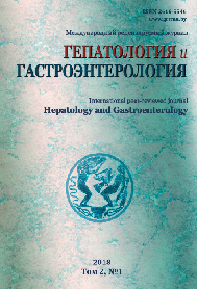ASSESSMENT OF ADDITIONAL METHODS OF SPONTANEOUS BACTERIAL PERITONITIS DIAGNOSIS IN PATIENTS WITH LIVER CIRRHOSIS
Abstract
Background. Additional research methods are being sought to diagnose spontaneous bacterial peritonitis (SBP).
Objective – to clarify the diagnostic significance of methods of counting polymorphonuclear leukocytes (PNL) in the automatic hematological analyzer (AHA) and definitions of PNL by using indicator test strips for urine analysis to diagnose SBP.
Materials and methods. The study of ascitic fluid (AF) was conducted in 57 patients with liver cirrhosis and ascites. PNL counting is performed using microscopy of AF by the manual method, in AHA (6410К NIHON KOHDEN, Japan), PNL was determined with indicatory test strips for urine analysis (URIstik A10, China and Multi Тест10, Republic of Belarus).
Results. Method of PNL calculation for the diagnosis of SBP using AHA NIHON KOHDEN 6410К demonstrates a low sensitivity (50.0%). A strong statistically significant correlation (r=0.880, 95% CI 0.804-0.928, p<0.001) between the total number of leukocytes (TNL) calculated by AHA and the number of PNL (in 1 μl) calculated by manual microscopy was established. For the diagnosis of SBP, the determination of TNL in AF by AHA an optimal sensitivity (Se)/specificity (Sp) ratio had a cut-off point of 400 cells in 1 μl, the most accurate threshold level was 900 cells in 1 μl. In the study of PNL in AF by using test strips, an optimal threshold value for the ratio Se/Sp for test strips URIstik A10 was 2, for Multi Тест10 – 1; maximum diagnostic accuracy had a value >3 for both sets.
Conclusion. Diagnosis of SBP can be carried out in combination with the PNL calculation in microscopy with methods of the TNL counting in AHA and with the help of test strips.
References
1. Jalan R, Fernandez J, Wiest R, Schnabl B, Moreau R, Angeli P, Stadlbauer V, Gustot T, Bernardi M, Canton R, Albillos A, Lammert F, Wilmer A, Mookerjee R, Vila J, Garcia-Martinez R, Wendon J, Such J, Cordoba J, Sanyal A, Garcia-Tsao G, Arroyo V, Burroughs A, Gines P. Bacterial infections in cirrhosis. A position statement based on the EASL Special Conference 2013. J. Hepatol. 2014;60(6):1310-1324. doi: 10.1016/j.jhep.2014.01.024.
2. Fernandez J, Gustot T. Management of bacterial infections in cirrhosis. J. Hepatol. 2012;56(Suppl 1):S1-12. doi: 10.1016/S0168-8278(12)60002-6.
3. European Association for the Study of the Liver. EASL clinical practice guidelines on the management of ascites, spontaneous bacterial peritonitis, and hepatorenal syndrome in cirrhosis. J. Hepatol. 2010;53(3):397-417. doi: 10.1016/j.jhep.2010.05.004.
4. Runyon BA. AASLD Practice Guideline. Introduction to the Revised American Association for the Study of Liver Diseases Practice Guideline. Management of Adult Patients With Ascites Due to Cirrhosis 2012. Hepatology. 2013;57(4):1651-1653. doi: 10.1002/hep.26359.
5. Fernandez J, Acevedo J, Prado V, Mercado M, Castro M, Pavesi M, Arteaga M, Sastre L, Juanola A, Gines P, Arroyo V. Clinical course and short-term mortality of cirrhotic patients with infections other than spontaneous bacterial peritonitis. Liver Int. 2017;37(3):385-395. doi: 10.1111/liv.13239.
6. Fasolato S, Angeli P, Dallagnese L, Maresio G, Zola E, Mazza E, Salinas F, Dona S, Fagiuoli S, Sticca A, Zanus G, Cillo U, Frasson I, Destro C, Gatta A. Renal failure and bacterial infections in patients with cirrhosis: epidemiology and clinical features. Hepatology. 2007;45(1):223-229. doi: 10.1002/hep.21443.
7. Gu C, Song MY, Sun WJ, Xu XY, Yang CQ, Chen DF. Advances in basic and clinical research on liver cirrhosis in 2016. Zhonghua Gan Zang Bing Za Zhi. 2017;25(1):5-8. doi: 10.3760/cma.j.issn.1007-3418.2017.01.003.
8. Shaikh, MM, Morgan M. Sepsis caused by Raoultella terrigena. JRSM Short Rep. 2011;2:49-51. doi: 10.1258/shorts.2011.010127.
9. Carrillo ER, Tellez MA, Salinas RS. Staphylococcus xylosus: una bacteria emergente. Rev. Med. Hosp. Gen. Mex. 2000;63(2):107-111.
10. Riggio O, Angeloni S, Parente A, Leboffe C, Pinto G, Aronne T, Merli M. Accuracy of the automated cell counters for management of spontaneous bacterial peritonitis. World J. Gastroenterol. 2008;14(37):5689-5694. doi: 10.3748/wjg.14.5689.
11. Angeloni S, Nicolini G, Merli M, Nicolao F, Pinto G, Aronne T, Attili AF, Riggio O. Validation of automated blood cell counter for the determination of polymorphonuclear cell count in the ascetic fluid of cirrhotic patients with or without spontaneous bacterial peritonitis. Am. J. Gastroenterol. 2003;98(8):1844-1848.
12. Nousbaum JB, Cadranel JF, Nahon P, Khac EN, Moreau R, Thevenot T, Silvain C, Bureau C, Nouel O, Pilette C, Paupard T, Vanbiervliet G, Oberti F, Davion T, Jouannaud V, Roche B, Bernard PH, Beaulieu S, Danne O, Thabut D, Chagneau-Derrode C, de Ledinghen V, Mathurin P, Pauwels A, Bronowicki JP, Habersetzer F, Abergel A, Audigier JC, Sapey T, Grange JD, Tran A. Diagnostic accuracy of the Multistix 8 SG reagent strip in diagnosis of spontaneous bacterial peritonitis. Hepatology. 2007;45(5):1275-1281. doi:10.1002/hep.21588.
13. Garcia-Tsao, G. Current management of the complications of cirrhosis and portal hypertension: variceal hemorrhage, ascites, and spontaneous bacterial peritonitis. Dig. Dis. 2016;34(4):382-386. doi: 10.1159/000444551.
14. Rimola A, Garcia-Tsao G, Navasa M, Piddock LJ, Planas R, Bernard B, Inadomi JM. Diagnosis, treatment and prophylaxis of spontaneous bacterial peritonitis: a consensus document. J. Hepatol. 2000;32(1):142-153.
15. Moore KP, Aithal GP. Guidelines on the management of ascites in cirrhosis. Gut. 2006;55(Suppl 6):1-12. doi: 10.1136/gut.2006.099580.
16. Lutz P, Pfarr K, Nischalke HD, Krämer B, Goeser F, Glässner A, Wolter F, Kokordelis P, Nattermann J, Sauerbruch T, Hoerauf A, Strassburg CP, Spengler U. The ratio of calprotectin to total protein as a diagnostic and prognostic marker for spontaneousbacterial peritonitis in patients with liver cirrhosis and ascites. Clin. Chem. Lab. Med. 2015;53(12):2031-2039. doi: 10.1515/cclm-2015-0284.
17. Lee SS, Min HJ, Choi JY, Cho HC, Kim JJ, Lee JM, Kim HJ, Ha CY, Kim HJ, Kim TH, Kim JH, Lee OJ. Usefulness of ascitic fluid lactoferrin levels in patients with liver cirrhosis. BMC Gastroenterol. 2016;16(1):132. doi:10.1186/s12876-016-0546-9.


















1.png)






